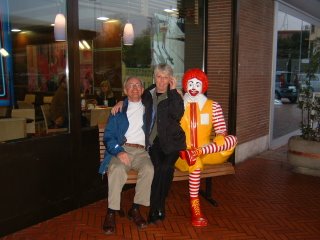Yes, after five days in Washington, we arrived in Munich the morning of April 5 and set off for Italy three days later. So why haven’t we posted something before now? Well, it’s because we need a wi-fi hot-spot to transfer photos and pre-written text to the internet, and in Munich we were too busy seeing friends (pictures below) and finalizing the administrative details of our trip to find one. Then we discovered that Venice does not offer technological curiosities like hot-spots to match its cultural delights, and our time in Ravenna and Assisi has been too short. This update is being posted from Rome, therefore.
Washington, March 30-April 4
We enjoyed the generous hospitality of daughter Schroeder and her partner Betsy, who were joined by Esme and Grace the last part of our stay, and Fritz was kind enough to travel down from New York for part of the weekend to join in sending us off. Georgia and her “sisters” had organized a retreat at the National Cathedral on Friday and Saturday while Todd, his former colleague Wayne Merry, and many lawyers—from a “white shoe” Washington firm (hired by Anatoliy Chubais’s UES), the State Department, and (by telephone) Moldova—discussed the possible contribution that Todd and Wayne could make, at the appellate level, to the defense of former Moldovan Defense Minister Valeriu Pasat. (You may have read that Pasat, now an employee of UES, the giant Russian electric company, has been sentenced to 10 years in the slammer for selling, when Todd was ambassador, MiG-29’s to the U.S. at too low a price and without parliamentary authority.) It is possible that Todd may have to return briefly to Washington to prepare his testimony, which could be written or oral. In the latter case he would have to make a short visit to Chisinau.
Munich, April 5-7
Munich was great—as it has always seemed since Todd served as a vice consul there from1963 to 1965, when he met some wonderful people with whom he has stayed in touch. One of these, Dirk-Peter Mueller, met us at the airport with his wife Frauke and our “new” four-year-old VW Passat (see photo), which Georgia, in one of her many inspired moments, has christened “Valeriu.” Dirk had arranged Valeriu’s purchase on our behalf, along with insurance and all other requisites, so we were ready to drive him upon our arrival.

In Munich we were guests of Peter and Gisela Wild, whose friendship also dates from the 1960’s. Our stay included some tourism (Marienplatz below) and two great Bavarian restaurant meals with these friends and others as evidenced by the following photos. (In case you were wondering, Munich beer has survived the predations of Brussels bureaucrats!) The only downside was the weather, with a snowstorm more reminiscent of Sun Valley than springtime Europe.
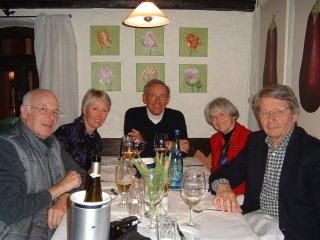
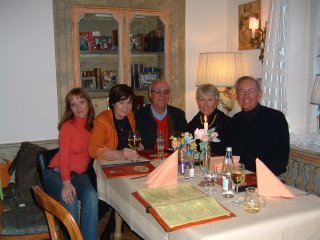
The day before Palm Sunday we crossed the Brenner Pass along with much of Germany, all of us headed for Goethe’s “Land wo die Zitronen bluehen.” The Austrian autobahn authorities thoughtfully provided electronic signs reading “Stau” (backup) after we had already been backed up for an hour. After a night in Mezzocorona we pushed on to visit Verona (pictures below) and Vicenza before arriving late that afternoon in Venice.

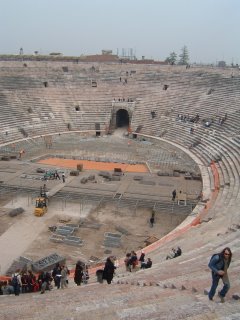
“We Open in Venice . . . ,” April 9-12
Neither of us had been in Venice before, and although we had read and heard much about the city, the reality was still overwhelming. We were impressed by the quality of Venetian food, astounded by the quality and quantity of Venetian art, amazed by the complexity of moving from place to place, overwhelmed by the beauty (see photo below), but dismayed by the degree of decay, especially the ubiquitous graffiti, which made much of the city look like a water-logged pre-Giuliani New York. We were very fortunate to stay in a private apartment, rented from a friend (see picture of Georgia standing at our door on a narrow calle), which gave us some appreciation of local life. This and another photo show some of Venice as we saw it, although no picture can begin to do justice to this extraordinary city.
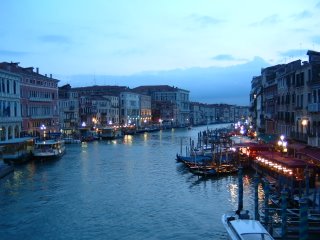
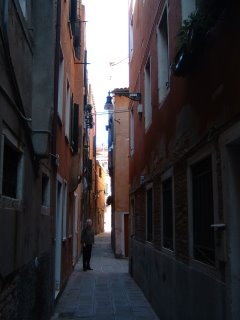

No, we didn’t go for a gondola ride, but we did have some adventures. Perhaps the best was finding a laundry, which turned into a treasure hunt where we were sent by one Venetian after another (remember: our Italian is non-existent) from campo to campo (square to square), starting at San Stefano and ending on a rio (canal) within shouting distance of the Piazzale Roma. And, yes, we were able to find our way back the next day to pick up our clothes.
Ravenna, April 13-14
Mosaics, mosaics, mosaics! They were the reason we came to Ravenna, and they did not disappoint. You’ve already probably seen the mosaic representations of Emperor Justinian and Empress Theodora in your art history text so we’re reproducing the equally stunning 6th century mosaic ceiling from the chancel of Sant’ Apollinare in Classe, a few kilometers out of town. “Refined” is the best adjective we can find to describe Ravenna with its great art, upscale shops, and excellent food at reasonable prices. Incidentally, although the second day of our visit was Good Friday, only a smattering of retail shops were closed.
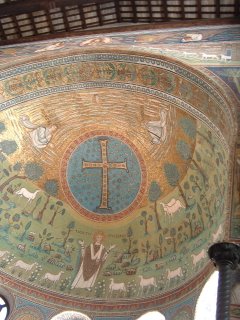
Perugia and Assisi, April 15
We crossed the Apennines on a highway Roman charioteers might have considered rough and reached Perugia, which offered extraordinary views of the Umbrian countryside. When in Perugia, we decided, one must buy some Perugina chocolate at the company’s downtown store, which was jammed with shoppers looking for chocolate delights for Easter. They were not disappointed, for the shelves were filled with giant bunnies and eggs. Sheepishly, we produced two euros for a Perugina chocolate bar and found a salesman willing to take our money.
Assisi looms from its hilly location at a visitor, and the first impression of distant grandeur is only reinforced by a closer approach. It is a beautiful town, immaculately maintained, a sort of Williamsburg version of 13th century Italy. The Giotto frescos depicting St. Francis’s life were as extraordinary as advertised in Todd’s freshman “Western Civ” text, but they and all the splendor of Assisi contrast with the simplicity and purity of the saint’s message. (Yes, we realize we are not the first to make this brilliant observation.)
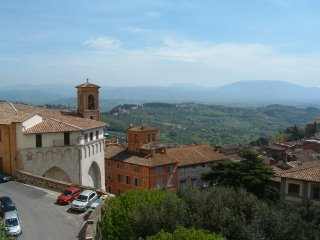
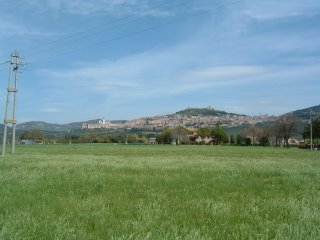
Perhaps here we might say a few words about the practicalities of our ramble. As this is Holy Week, we decided it would be prudent to book almost all our accommodations in advance, using Orbitz or one of the other on-line agencies, aiming at lodgings that would cost no more than a decent U.S. motel. Later, as we did in Mezzocorona, we will simply choose a hotel or inn after pulling into town, probably aided by the red Michelin guide, although we will probably continue to book in advance for major cities. Our restaurant choices have been largely selected from Michelin’s recommendations, from which we picked establishments that fell into the guide’s “good value for the money” category. The results, so far, have been good. In short, this is a Europe on Five Dollars a Day approach for the geriatric set, neither hostels nor the Gritti Palace.
Tivoli and Rome, April 16 (Easter)
One of the advantages of Valeriu is the ability to make side trips on the spur of the moment. When planning our route from Assisi to Rome, we realized that we could easily spend a warm, sunny afternoon in Tivoli, which had been highly recommended by friends. Hence, we were able to visit Hadrian’s Villa, constructed in the 2nd Century but badly misnamed since the “villa” was the size of a village, and Villa d’Este with its fantastic gardens, built by Cardinal Hippolito d’Este in the 16th Century as a sort of retirement home after he had been canned by the French king as his first minister. Like Michelin, we would rate both as “worth a journey,” but Villa d’Este was particularly memorable as the peonies and wisteria were in full bloom.

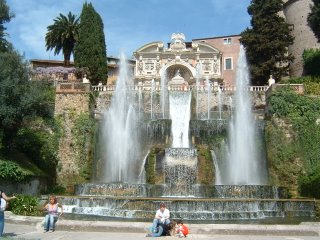
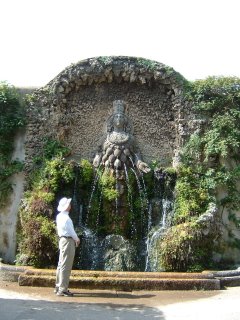
From Tivoli we drove straight (perhaps that’s not quite the right word) to our hotel in northeast Rome with Todd hunched over the wheel and Georgia reading the map. Frustrated by our unwillingness to exceed the speed limit, several Romans passed us where there was only room for one car to maneuver. Georgia’s navigation proved faultless so we were able to put Valeriu into the hotel garage without incident and ready ourselves for a meal in one of the few neighborhood trattorias open on Easter.
